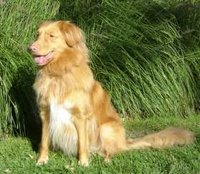Yarmouth Toller
 Sporting Group dog. The Nova Scotia Duck Tolling Retriever or Little River Duck Dog, or Yarmouth Toller was developed in Nova Scotia in the early 19th Century to toll (or lure) and retrieve waterfowl. The tolling dog runs, jumps, and plays along the shoreline in full view of a flock of ducks, occasionally disappearing from sight and then quickly reappearing, aided by the hunter, who throws small sticks or a ball for the dog. The dog's playful actions arouse the curiosity of the ducks swimming offshore and they are lured within gunshot range. The Toller is subsequently sent out to retrieve the dead or wounded birds. The Toller is a medium-sized, powerful, compact, balanced, well-muscled dog. He should show a high degree of agility, alertness, and determination. Many Tollers have a slightly sad expression until they go to work - then their appearance changes to intense concentration and excitement. At work, the dog has a speedy, rushing action, with the head carried out almost level with the back and heavily-feathered tail in constant motion.
Sporting Group dog. The Nova Scotia Duck Tolling Retriever or Little River Duck Dog, or Yarmouth Toller was developed in Nova Scotia in the early 19th Century to toll (or lure) and retrieve waterfowl. The tolling dog runs, jumps, and plays along the shoreline in full view of a flock of ducks, occasionally disappearing from sight and then quickly reappearing, aided by the hunter, who throws small sticks or a ball for the dog. The dog's playful actions arouse the curiosity of the ducks swimming offshore and they are lured within gunshot range. The Toller is subsequently sent out to retrieve the dead or wounded birds. The Toller is a medium-sized, powerful, compact, balanced, well-muscled dog. He should show a high degree of agility, alertness, and determination. Many Tollers have a slightly sad expression until they go to work - then their appearance changes to intense concentration and excitement. At work, the dog has a speedy, rushing action, with the head carried out almost level with the back and heavily-feathered tail in constant motion.
Size: Height at the withers - males, 18-21 inches. The ideal is 19 inches. Females, 17-20 inches. The ideal is 18 inches. Bone: is medium. Weight is in proportion to height and bone of the dog. The dog's length should be slightly longer than height, in a ratio of 10 to 9, but should not give the impression of a long back.
Toller is a very intelligent dog. They respond to many cues of normal family life. Rarely can an owner pick up keys and not find the Toller at the back door. The click of a shell being chambered in the gun will light up the eyes and the dog will raise up almost on tip-toes.
Many Toller owners who compete in Obedience report that the dog is happiest when working. However, they also report the Toller has its own timetable for learning. They are bright, intelligent, and easy to train if you are experienced. However, they are ardent observers of life and as young dogs are easily distracted in the ring. While they learn quickly, they also bore quickly. Training sessions must be kept short and light, fun and challenging.
Training a Toller is best based on communicating your knowledge to him in whatever field you are working. There are a good number of members in each area who are happy to pass on their success AND not so successful stories in an effort to make it easier for you and your Toller.
The Nova Scotia Duck Tolling Retriever has broken free of the constraints of the hunting technique for which it's named. Today the Toller is multi-faceted. You get the ideal dog...a retriever, a hunter, a loyal watchdog, a show dog (obedience or conformation) and a wonderful loving pet all rolled into one!
Source: Askedweb information portal
0 comments:
Post a Comment